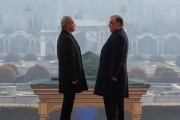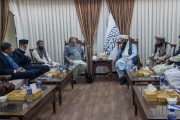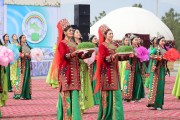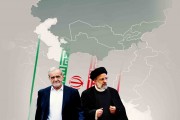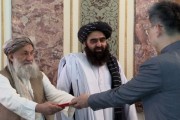Publish Date
Saturday 10 October 2020 - 10:17
recommended
0
The 5+1 platforms and the political Great Game in Central Asia
Russia has so far shown no opposition to the presence of the regional countries in the regional convergence platforms and it seems that Moscow does not see the level of movements as contradictory to its interests, at least in the short term. But, at the same time Moscow has a negative and pessimistic view towards the movements of United States.
By: Omid Rahimi
Introduction
So far, many countries have participated in the 5+1 platforms of Central Asia, including major international and even regional actors. Among the major international actors, one can refer to China and the United States, and among the regional powers to South Korea, Japan and India. Although the nature of the Central Asian countries' interactions in these platforms usually turns around the political issues focusing on the expansion of trade ties, in some cases the non-aligned nature of the interests leads these countries towards Confrontational patterns, such as competition or conflict.
The most serious competitive atmosphere right now is related to the triangle of China, the United States and Russia. Russia has started its political, economic, and security relations with the regional countries a long time ago within the frameworks of the traditional platforms, and now seems to be watching and balancing the competition of two key 5 + 1 platforms between China and the United States. In fact, although Russia does not benefit from supporting any of these platforms (except for the cases that are related to the regional powers), it has sought to create a positive balance in China's favor versus the U.S. in the region.
For example, as long as Moscow has no control over energy routes in Central Asia, it prefers the formation of more neutral eastern routes to China instead of the southern or western routes such as the TAPI or Trans-Caspian, which are designed to serve the U.S. interests.
The United States’ 5+1 meeting with the Central Asian countries
On June 30, a meeting of the Central Asian and U.S. foreign ministers was held in the form of C5+1 video conference. The meeting was attended by the foreign ministers of all five Central Asian republics and U.S. Secretary of State Mike Pompeo as well as his deputy, David Hale. The foreign ministries of the five Central Asian countries announced the meeting only through the news outlets. And only a day after the meeting, U.S. Deputy Assistant Secretary of State for South and Central Asian Affairs Jonathan Henick held a virtual press conference to provide further details. According to Henick, in this meeting, the 5+1 countries mainly discussed about the challenges of the COVID-19 pandemic and Pompeo also repeated his country’s commitment to the independence, sovereignty and territorial integrity of the five Central Asian states. He described this commitment as "the cornerstone" of the U.S. strategy towards Central Asia, adding that Washington is sensitive towards the region's stability, prosperity, and security.
Henick noted that the U.S. policy has always been to ensure that the Central Asian republics can freely choose their partners in pursuit of their national interests and not to be economically dependent on a specific country.
He also went on to say that Washington is seeking to create a more interconnected, prosperous, and secure region which would benefit the five Central Asian countries, the United States, and the international community. He described the 5+1 video conference as a sign of Commitment of the participating countries to this form of cooperation and called the forum as an example of a "flexible and inclusive multilateralism" that the United States is looking for.
Henick added that the joint projects are being implemented within the framework of the 5+1, are meant to serve the participating countries common goals, including the expansion of the economic relations, reduction of environmental issues, and elimination of security threats and it is only through cooperation that they can build a more interconnected, prosperous, and secure region.
Henick also stressed that the United States has asked its partners in Central Asia to accelerate their political and economic reforms in a bid to strengthen their own economic stability and diversity, thereby paving the way for the U.S. and foreign investments.
In the final part of his speech, the U.S. deputy assistant secretary of state noted that the regional peace and security, including the Afghan peace process, were also discussed at the 5+1 meeting. He further reiterated that Washington hopes to see the intra-Afghan talks ending the war in the country, something that would definitely benefit Afghanistan’s neighbors.
According to Henick, The United States believes that a stable and prosperous Afghanistan is crucial to peace and security in Central Asia; so the U.S. appreciates the cooperation and assistance of its partners in the 5+1 to achieve this common goal.
Henick's statement about the 5+1 summit shows that distancing the Central Asian countries from their neighboring powers, especially Russia and China, is still Washington's top priority in establishing such a framework. Henick explicitly states that the U.S. policy has always been to ensure that the Central Asian republics can freely choose their partners in pursuit of their national interests and not to be economically dependent on a specific country. Such a statement reflects the fact that the countries of Central Asia are not yet fully independent and must be helped to make the "right choice" between different partners and options. Although this claim completely contradicts the position of the regional countries - because they consider themselves to have full independence and sovereignty, and on this basis they have become a member of the United Nations -, It is clear that by stating “a specific country,” Henick means Russia (Washington’s traditional rival) and that he wants to take advantage of the 5+1 meeting against Moscow’s interests.
At the time of Pompeo's visit to the region in February, which took place on the eve of the 5 + 1 meeting in Tashkent, Russian Foreign Minister Sergei Lavrov harshly criticized the U.S. measures in the region. He explicitly noted that Washington's main goal is to direct all the projects southward, namely Afghanistan, with participation of the Central Asian countries, except Russia.
Henick's statement that "only through joint cooperation we can build a more interconnected, prosperous, and secure region in Central Asia" actually targets the U.S. geopolitical rivals, specifically Russia and China. To this end, special emphasis is placed over "a more secure area" phrase. This will send the message that the Central Asian countries cannot guarantee their stability and security versus Russia and China without the presence and influence of the United States.
It seems that the new 5+1 meeting had no remarkable achievement. Although the goal of the 5+1 format is to promote the political, economic and social convergence of the Central Asian states, all members are almost pursuing their own national goals. This fact can be easily understood through the speeches of the Central Asian foreign ministers.
Uzbek Foreign Minister Abdulaziz Kamilov made some proposals for more regional cooperation in digital economy, transport, agricultural innovations, energy resources, and improvement of economic and social conditions. But, the realization of these suggestions needs time as well as securing the national interests of all countries in the region. Therefore, we cannot expect tangible results in these areas in the near future. In his speech, Kazakh Foreign Minister Mukhtar Tleuberdi called on Washington to invest in and help bring American technology to the region using the "5 + 1" format and the Astana International Financial Center. (AIFC).
Meanwhile, the promise of Adam Boehler, the CEO of U.S. International Development Finance Corporation (DFC), in this meeting to provide financial support for joint projects, does not necessarily mean that he will fulfill it, because this has previously happened to other regional projects such as CASA-1000, TAPI, TUTAP, and so on. When a regional project is in the interests of the United States, it will support it politically, but mainly will pay a little money for it and placing the main financial burden on other participants. For example, Mike Pompeo announced during a visit to Uzbekistan in February that the United States would allocate $1 million for expansion of trade between this country and Afghanistan. So, Central Asia is not an exception to this political-financial behavior of the U.S. Lack of any US-backed economic or infrastructure projects in the region actually confirms this fact.
On the other hand, the US deputy assistant secretary of state clearly stated that his country's investment in Central Asia is subject to implementation of "political and economic reforms" in the region, including the protection of human rights, creating a favorable environment for investment and economic diversity and stability. But it is already clear that due to the political environment of the Central Asian countries and their nearly three decades of governing experience, the conditions set by Washington are not going to happen. And it means that Washington will always have a good excuse to evade any investment in the region. For that reason, the proposals of the regional foreign ministers, including Kyrgyzstan, Tajikistan and Turkmenistan, about the regional cooperation in the form of "5 + 1" - in the fields of economy, transportation infrastructure, water and energy, etc. - in the coming years are unlikely to happen.
As previously mentioned, the points raised by the Central Asian foreign ministers are more related to their own national issues and the regional aspect is of secondary importance. It seems that the governments of Central Asia are at a crossroads of national and regional interests, and they still have not found the opportunity to somehow align them. The presence of Zalmay Khalilzad, the U.S. special representative for Afghanistan Reconciliation, can reveal Washington’s intention of holding this round of 5+1 talks. Khalilzad, who joined the foreign ministers in Tashkent, arrived in Uzbekistan after participating in meetings about Afghan peace talks in Doha and Islamabad. Holding the 5+1 meetings in such a situation indicates that the United States is looking at Uzbekistan as a trusted partner which can help to the Afghan peace scenario. So, with Khalilzad in Tashkent, the US wants to encourage the country to play a more prominent role in Afghanistan.
Although the role of other Central Asian countries in this scenario is not so significant, Washington wants to give a regional and international credibility to its actions by involving them in this process. Although the Central Asian countries are interested to see Afghanistan’s stability as soon as possible, the U.S. seeks to isolate Russia and Iran or downplay their role through such interactions with the Central Asian states. Therefore, it can be concluded that more than helping the real regional convergence in Central Asia, the 5+1 is designed to satisfy the interests of the U.S. against its geopolitical rivals, especially Russia, China, and Iran.
China’s 5+1 meeting with the Central Asian countries
Two weeks after Washington’s 5+1 meeting with the Central Asian republics, the first meeting of these countries and China was held on July 16 via a video conference. The meeting was also attended by the foreign ministers of the five Central Asian republics and the Chinese foreign minister. During the meeting, the foreign ministers of Central Asia and China stressed on strengthening of multilateral cooperation based on friendship, good neighborliness, and mutual benefits. The Central Asian foreign ministers called for fight against the coronavirus and its negative consequences as well as the revival of the region's national economies, as their first priority. According to them, the measures taken to prevent the spread of the virus have led to a significant reduction of domestic activities and foreign economic relations in the region. The participating countries also expressed support for joint efforts to strengthen the economic convergence, trade ties and mutual investments.
Given the current quarantine measures at the borders, the issue of transportation and transit has also become particularly important. So, in this session, China announced its readiness to organize Green Corridors to provide uninterrupted transportation of goods to this region.
The foreign ministers of Central Asia and China also discussed the possibility of cooperation in the fields of digitalization, financial services, e-commerce, smart cities and other technical grounds. They also stressed the need for expansion of scientific interactions, especially in production of pharmaceutical products. Finally, the meeting was ended with the signing of a joint statement.
In his speech, Chinese Foreign Minister Wang Yi reiterated that his country attaches great importance to developing a strategic partnership with the Central Asian countries based on mutual needs. He also noted that Beijing's relations with Central Asia are not against any other country and will not affect other bilateral or multilateral relations in the region. Joint effort against the coronavirus epidemic, improvement of the economic situation, maintenance of the regional security (including the Afghan peace process), and expansion of multilateral cooperation have been among other issues that were emphasized by Wang Yi.
China, despite having close bilateral relations with the Central Asian countries, has ultimately resorted to the pattern that other powers have been using for many years in their interactions with Central Asia. For example, we can refer to the 5+1 meetings of Japan, the European Union, the United States, Korea and India with the Central Asia states. Most of these countries describe their purpose of holding meetings in such a format as helping to form cooperation with Central Asia as a united region. In other words, their main purpose is to create a united and cohesive area, downplay Russia’s role in the region and drive a wedge between the five Central Asian countries and Moscow.
Meanwhile, this is the first time that China is entering an interaction with Central Asia without Russia’s presence. It is not clear yet that what would be the consequences and messages of such a move for Russia, because the Central Asian states usually consider the simultaneous presence of Russia and China in different frameworks as an opportunity to create a kind of balance between the interests of these two powers.
Now, the question is this: Why China, as a country that enjoys increasing influence in Central Asia and can resolve all the regional issues through bilateral solutions, has resorted to the 5+1 model? It is worth mentioning that all the decisions in the Central Asian countries are made by the high-ranking elites and public opinion does not play an important role. In other words, China could continue to achieve its goals in the region through the bilateral interactions.
According to some analysts, China is eager to see a kind of consensus among the region's top elites over the important issues. For example, it is said that China wants to pursue its unfulfilled economic and financial programs in the Shanghai Cooperation Organization through the 5+1 format. It means that Beijing's view towards this new form of cooperation is that it can provide better opportunities for expansion of China’s economic presence in the region. On the other hand, China is trying to reduce the competition of the region's ruling elites through holding regular joint sessions in a bid to avoid facing any serious obstacle in executing infrastructure projects in this important geographical area. It is noteworthy that, unlike a few years ago, the issue of convergence in Central Asia is now supported by the regional governments and communities, and China is seeking to seize this opportunity.
Of course, the elites of Central Asia have also come to the conclusion that if they create a united region, foreign attentions, especially from the influential countries and international organizations, will increase. Undoubtedly, in addition to the economic interests, China is also pursuing its strategic goals in security areas, the most important of which is participation of the regional states in the fight against terrorism, extremism, and separatism. This issue has gained a particular significance in the context of the US sanctions against China and also Washington's Chinaophobia project in Central Asia by focusing on the issue of anti-Uyghurism in Xinjiang. By using the 5+1 format, China wants to achieve a unified front in Central Asia against the U.S. and turn the region into a stable security depth for itself.
It is natural that the deepening of China's cooperation with the Central Asian countries in the political, economic and security fields would lead to the increase of Beijing's influence in the region. Through resorting to different cooperation models, the Central Asian states are also seeking to take different advantages, reduce their economic dependence on a specific foreign country (including Russia) and create a balance between the interests of major powers.
Conclusion
The approaches of the United States and China in the 5+1 platforms indicate the beginning of a new round of political relations. In their political stances, both countries explicitly emphasize the strategy of non-confrontation with Moscow, but with emphasis on propositions such as “reducing the dependence of the Central Asian states over a specific country”, informally moving towards reduction of Moscow's influence.
On the other hand, Russia has so far shown no opposition to the presence of the regional countries in these platforms and it seems that does not see, at least in the short term, the level of movements as contradictory to its interests. But, at the same time it has a negative and pessimistic view towards the movements of United States.
Another remarkable point in these political approaches is the emphasis over formation of a competitive cooperation between Kazakhstan and Uzbekistan. Kyrgyzstan and Tajikistan's great dependence on Russia, and Turkmenistan's neutrality have made them less attractive to China and the United States. However, recent developments in Uzbekistan, and also growing empowering of Kazakhstan, which have increased the relative independence of the both actors, have pushed Beijing and Washington towards playing with the ambitions of Tashkent and Nursultan.
Meanwhile, the Central Asian countries seem to be looking for a two-dimensional balance within the 5+1 formats rather than a multidimensional approach. For these countries, there is a smaller multidimensional view within a larger two-dimensional approach: a multidimensional view to create a balance between China, the United States, and the smaller actors such as India, South Korea, and Japan, and at the same time, a two dimensional balancing approach between this multidimensional view and Moscow’s approach in the region.
In the context of this multifaceted system and complex inter-relationships, securing the significant med-term benefits in a way that reduces the potential tensions with Moscow, can provide these countries with significant tools.
Of course, it should be noted again that countries such as Tajikistan and Kyrgyzstan, due to high level of dependence on Russia and also inability to use these tools, cannot play in this game and this is designed for Uzbekistan, Kazakhstan, and to a lesser extent for Turkmenistan.
Meanwhile, Moscow's pragmatic response to the upcoming developments could be very important. The post-corona world is considered by many analysts to be a new world with a different distribution of power and distinct international arrangements. In this new world, the distance between the international powers will change, and consequently the traditional influence of the countries will change. This means that any change in potential abilities of the international and regional powers in changing the existing equations can pave the way for changes within these political platforms.
The emergence of temporary political or socio-economic crises and the ability of these platforms to resolve them can be very crucial. It seems that both the United States and Russia should consider a special role for China in the post-corona world, in which promotion of the previous economic arrangements, development of Chinese platforms, and expansion of China's security cooperation in Central Asia seem inevitable.
Developments that may take place in the context of a new political Great Game.
Introduction
So far, many countries have participated in the 5+1 platforms of Central Asia, including major international and even regional actors. Among the major international actors, one can refer to China and the United States, and among the regional powers to South Korea, Japan and India. Although the nature of the Central Asian countries' interactions in these platforms usually turns around the political issues focusing on the expansion of trade ties, in some cases the non-aligned nature of the interests leads these countries towards Confrontational patterns, such as competition or conflict.
The most serious competitive atmosphere right now is related to the triangle of China, the United States and Russia. Russia has started its political, economic, and security relations with the regional countries a long time ago within the frameworks of the traditional platforms, and now seems to be watching and balancing the competition of two key 5 + 1 platforms between China and the United States. In fact, although Russia does not benefit from supporting any of these platforms (except for the cases that are related to the regional powers), it has sought to create a positive balance in China's favor versus the U.S. in the region.
For example, as long as Moscow has no control over energy routes in Central Asia, it prefers the formation of more neutral eastern routes to China instead of the southern or western routes such as the TAPI or Trans-Caspian, which are designed to serve the U.S. interests.
The United States’ 5+1 meeting with the Central Asian countries
On June 30, a meeting of the Central Asian and U.S. foreign ministers was held in the form of C5+1 video conference. The meeting was attended by the foreign ministers of all five Central Asian republics and U.S. Secretary of State Mike Pompeo as well as his deputy, David Hale. The foreign ministries of the five Central Asian countries announced the meeting only through the news outlets. And only a day after the meeting, U.S. Deputy Assistant Secretary of State for South and Central Asian Affairs Jonathan Henick held a virtual press conference to provide further details. According to Henick, in this meeting, the 5+1 countries mainly discussed about the challenges of the COVID-19 pandemic and Pompeo also repeated his country’s commitment to the independence, sovereignty and territorial integrity of the five Central Asian states. He described this commitment as "the cornerstone" of the U.S. strategy towards Central Asia, adding that Washington is sensitive towards the region's stability, prosperity, and security.
Henick noted that the U.S. policy has always been to ensure that the Central Asian republics can freely choose their partners in pursuit of their national interests and not to be economically dependent on a specific country.
He also went on to say that Washington is seeking to create a more interconnected, prosperous, and secure region which would benefit the five Central Asian countries, the United States, and the international community. He described the 5+1 video conference as a sign of Commitment of the participating countries to this form of cooperation and called the forum as an example of a "flexible and inclusive multilateralism" that the United States is looking for.
Henick added that the joint projects are being implemented within the framework of the 5+1, are meant to serve the participating countries common goals, including the expansion of the economic relations, reduction of environmental issues, and elimination of security threats and it is only through cooperation that they can build a more interconnected, prosperous, and secure region.
Henick also stressed that the United States has asked its partners in Central Asia to accelerate their political and economic reforms in a bid to strengthen their own economic stability and diversity, thereby paving the way for the U.S. and foreign investments.
In the final part of his speech, the U.S. deputy assistant secretary of state noted that the regional peace and security, including the Afghan peace process, were also discussed at the 5+1 meeting. He further reiterated that Washington hopes to see the intra-Afghan talks ending the war in the country, something that would definitely benefit Afghanistan’s neighbors.
According to Henick, The United States believes that a stable and prosperous Afghanistan is crucial to peace and security in Central Asia; so the U.S. appreciates the cooperation and assistance of its partners in the 5+1 to achieve this common goal.
Henick's statement about the 5+1 summit shows that distancing the Central Asian countries from their neighboring powers, especially Russia and China, is still Washington's top priority in establishing such a framework. Henick explicitly states that the U.S. policy has always been to ensure that the Central Asian republics can freely choose their partners in pursuit of their national interests and not to be economically dependent on a specific country. Such a statement reflects the fact that the countries of Central Asia are not yet fully independent and must be helped to make the "right choice" between different partners and options. Although this claim completely contradicts the position of the regional countries - because they consider themselves to have full independence and sovereignty, and on this basis they have become a member of the United Nations -, It is clear that by stating “a specific country,” Henick means Russia (Washington’s traditional rival) and that he wants to take advantage of the 5+1 meeting against Moscow’s interests.
At the time of Pompeo's visit to the region in February, which took place on the eve of the 5 + 1 meeting in Tashkent, Russian Foreign Minister Sergei Lavrov harshly criticized the U.S. measures in the region. He explicitly noted that Washington's main goal is to direct all the projects southward, namely Afghanistan, with participation of the Central Asian countries, except Russia.
Henick's statement that "only through joint cooperation we can build a more interconnected, prosperous, and secure region in Central Asia" actually targets the U.S. geopolitical rivals, specifically Russia and China. To this end, special emphasis is placed over "a more secure area" phrase. This will send the message that the Central Asian countries cannot guarantee their stability and security versus Russia and China without the presence and influence of the United States.
It seems that the new 5+1 meeting had no remarkable achievement. Although the goal of the 5+1 format is to promote the political, economic and social convergence of the Central Asian states, all members are almost pursuing their own national goals. This fact can be easily understood through the speeches of the Central Asian foreign ministers.
Uzbek Foreign Minister Abdulaziz Kamilov made some proposals for more regional cooperation in digital economy, transport, agricultural innovations, energy resources, and improvement of economic and social conditions. But, the realization of these suggestions needs time as well as securing the national interests of all countries in the region. Therefore, we cannot expect tangible results in these areas in the near future. In his speech, Kazakh Foreign Minister Mukhtar Tleuberdi called on Washington to invest in and help bring American technology to the region using the "5 + 1" format and the Astana International Financial Center. (AIFC).
Meanwhile, the promise of Adam Boehler, the CEO of U.S. International Development Finance Corporation (DFC), in this meeting to provide financial support for joint projects, does not necessarily mean that he will fulfill it, because this has previously happened to other regional projects such as CASA-1000, TAPI, TUTAP, and so on. When a regional project is in the interests of the United States, it will support it politically, but mainly will pay a little money for it and placing the main financial burden on other participants. For example, Mike Pompeo announced during a visit to Uzbekistan in February that the United States would allocate $1 million for expansion of trade between this country and Afghanistan. So, Central Asia is not an exception to this political-financial behavior of the U.S. Lack of any US-backed economic or infrastructure projects in the region actually confirms this fact.
On the other hand, the US deputy assistant secretary of state clearly stated that his country's investment in Central Asia is subject to implementation of "political and economic reforms" in the region, including the protection of human rights, creating a favorable environment for investment and economic diversity and stability. But it is already clear that due to the political environment of the Central Asian countries and their nearly three decades of governing experience, the conditions set by Washington are not going to happen. And it means that Washington will always have a good excuse to evade any investment in the region. For that reason, the proposals of the regional foreign ministers, including Kyrgyzstan, Tajikistan and Turkmenistan, about the regional cooperation in the form of "5 + 1" - in the fields of economy, transportation infrastructure, water and energy, etc. - in the coming years are unlikely to happen.
As previously mentioned, the points raised by the Central Asian foreign ministers are more related to their own national issues and the regional aspect is of secondary importance. It seems that the governments of Central Asia are at a crossroads of national and regional interests, and they still have not found the opportunity to somehow align them. The presence of Zalmay Khalilzad, the U.S. special representative for Afghanistan Reconciliation, can reveal Washington’s intention of holding this round of 5+1 talks. Khalilzad, who joined the foreign ministers in Tashkent, arrived in Uzbekistan after participating in meetings about Afghan peace talks in Doha and Islamabad. Holding the 5+1 meetings in such a situation indicates that the United States is looking at Uzbekistan as a trusted partner which can help to the Afghan peace scenario. So, with Khalilzad in Tashkent, the US wants to encourage the country to play a more prominent role in Afghanistan.
Although the role of other Central Asian countries in this scenario is not so significant, Washington wants to give a regional and international credibility to its actions by involving them in this process. Although the Central Asian countries are interested to see Afghanistan’s stability as soon as possible, the U.S. seeks to isolate Russia and Iran or downplay their role through such interactions with the Central Asian states. Therefore, it can be concluded that more than helping the real regional convergence in Central Asia, the 5+1 is designed to satisfy the interests of the U.S. against its geopolitical rivals, especially Russia, China, and Iran.
China’s 5+1 meeting with the Central Asian countries
Two weeks after Washington’s 5+1 meeting with the Central Asian republics, the first meeting of these countries and China was held on July 16 via a video conference. The meeting was also attended by the foreign ministers of the five Central Asian republics and the Chinese foreign minister. During the meeting, the foreign ministers of Central Asia and China stressed on strengthening of multilateral cooperation based on friendship, good neighborliness, and mutual benefits. The Central Asian foreign ministers called for fight against the coronavirus and its negative consequences as well as the revival of the region's national economies, as their first priority. According to them, the measures taken to prevent the spread of the virus have led to a significant reduction of domestic activities and foreign economic relations in the region. The participating countries also expressed support for joint efforts to strengthen the economic convergence, trade ties and mutual investments.
Given the current quarantine measures at the borders, the issue of transportation and transit has also become particularly important. So, in this session, China announced its readiness to organize Green Corridors to provide uninterrupted transportation of goods to this region.
The foreign ministers of Central Asia and China also discussed the possibility of cooperation in the fields of digitalization, financial services, e-commerce, smart cities and other technical grounds. They also stressed the need for expansion of scientific interactions, especially in production of pharmaceutical products. Finally, the meeting was ended with the signing of a joint statement.
In his speech, Chinese Foreign Minister Wang Yi reiterated that his country attaches great importance to developing a strategic partnership with the Central Asian countries based on mutual needs. He also noted that Beijing's relations with Central Asia are not against any other country and will not affect other bilateral or multilateral relations in the region. Joint effort against the coronavirus epidemic, improvement of the economic situation, maintenance of the regional security (including the Afghan peace process), and expansion of multilateral cooperation have been among other issues that were emphasized by Wang Yi.
China, despite having close bilateral relations with the Central Asian countries, has ultimately resorted to the pattern that other powers have been using for many years in their interactions with Central Asia. For example, we can refer to the 5+1 meetings of Japan, the European Union, the United States, Korea and India with the Central Asia states. Most of these countries describe their purpose of holding meetings in such a format as helping to form cooperation with Central Asia as a united region. In other words, their main purpose is to create a united and cohesive area, downplay Russia’s role in the region and drive a wedge between the five Central Asian countries and Moscow.
Meanwhile, this is the first time that China is entering an interaction with Central Asia without Russia’s presence. It is not clear yet that what would be the consequences and messages of such a move for Russia, because the Central Asian states usually consider the simultaneous presence of Russia and China in different frameworks as an opportunity to create a kind of balance between the interests of these two powers.
Now, the question is this: Why China, as a country that enjoys increasing influence in Central Asia and can resolve all the regional issues through bilateral solutions, has resorted to the 5+1 model? It is worth mentioning that all the decisions in the Central Asian countries are made by the high-ranking elites and public opinion does not play an important role. In other words, China could continue to achieve its goals in the region through the bilateral interactions.
According to some analysts, China is eager to see a kind of consensus among the region's top elites over the important issues. For example, it is said that China wants to pursue its unfulfilled economic and financial programs in the Shanghai Cooperation Organization through the 5+1 format. It means that Beijing's view towards this new form of cooperation is that it can provide better opportunities for expansion of China’s economic presence in the region. On the other hand, China is trying to reduce the competition of the region's ruling elites through holding regular joint sessions in a bid to avoid facing any serious obstacle in executing infrastructure projects in this important geographical area. It is noteworthy that, unlike a few years ago, the issue of convergence in Central Asia is now supported by the regional governments and communities, and China is seeking to seize this opportunity.
Of course, the elites of Central Asia have also come to the conclusion that if they create a united region, foreign attentions, especially from the influential countries and international organizations, will increase. Undoubtedly, in addition to the economic interests, China is also pursuing its strategic goals in security areas, the most important of which is participation of the regional states in the fight against terrorism, extremism, and separatism. This issue has gained a particular significance in the context of the US sanctions against China and also Washington's Chinaophobia project in Central Asia by focusing on the issue of anti-Uyghurism in Xinjiang. By using the 5+1 format, China wants to achieve a unified front in Central Asia against the U.S. and turn the region into a stable security depth for itself.
It is natural that the deepening of China's cooperation with the Central Asian countries in the political, economic and security fields would lead to the increase of Beijing's influence in the region. Through resorting to different cooperation models, the Central Asian states are also seeking to take different advantages, reduce their economic dependence on a specific foreign country (including Russia) and create a balance between the interests of major powers.
Conclusion
The approaches of the United States and China in the 5+1 platforms indicate the beginning of a new round of political relations. In their political stances, both countries explicitly emphasize the strategy of non-confrontation with Moscow, but with emphasis on propositions such as “reducing the dependence of the Central Asian states over a specific country”, informally moving towards reduction of Moscow's influence.
On the other hand, Russia has so far shown no opposition to the presence of the regional countries in these platforms and it seems that does not see, at least in the short term, the level of movements as contradictory to its interests. But, at the same time it has a negative and pessimistic view towards the movements of United States.
Another remarkable point in these political approaches is the emphasis over formation of a competitive cooperation between Kazakhstan and Uzbekistan. Kyrgyzstan and Tajikistan's great dependence on Russia, and Turkmenistan's neutrality have made them less attractive to China and the United States. However, recent developments in Uzbekistan, and also growing empowering of Kazakhstan, which have increased the relative independence of the both actors, have pushed Beijing and Washington towards playing with the ambitions of Tashkent and Nursultan.
Meanwhile, the Central Asian countries seem to be looking for a two-dimensional balance within the 5+1 formats rather than a multidimensional approach. For these countries, there is a smaller multidimensional view within a larger two-dimensional approach: a multidimensional view to create a balance between China, the United States, and the smaller actors such as India, South Korea, and Japan, and at the same time, a two dimensional balancing approach between this multidimensional view and Moscow’s approach in the region.
In the context of this multifaceted system and complex inter-relationships, securing the significant med-term benefits in a way that reduces the potential tensions with Moscow, can provide these countries with significant tools.
Of course, it should be noted again that countries such as Tajikistan and Kyrgyzstan, due to high level of dependence on Russia and also inability to use these tools, cannot play in this game and this is designed for Uzbekistan, Kazakhstan, and to a lesser extent for Turkmenistan.
Meanwhile, Moscow's pragmatic response to the upcoming developments could be very important. The post-corona world is considered by many analysts to be a new world with a different distribution of power and distinct international arrangements. In this new world, the distance between the international powers will change, and consequently the traditional influence of the countries will change. This means that any change in potential abilities of the international and regional powers in changing the existing equations can pave the way for changes within these political platforms.
The emergence of temporary political or socio-economic crises and the ability of these platforms to resolve them can be very crucial. It seems that both the United States and Russia should consider a special role for China in the post-corona world, in which promotion of the previous economic arrangements, development of Chinese platforms, and expansion of China's security cooperation in Central Asia seem inevitable.
Developments that may take place in the context of a new political Great Game.
Omid Rahimi is a Researcher at the Institute for East Strategic Studies
News code:2402







